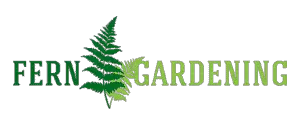When starting out with ferns, it makes sense to choose varieties that are easy to grow. Depending on your priorities, this could mean ferns that do not need much looking after, ferns that grow rapidly and put on a lot of foliage, or ferns that are resilient in all weathers.
The easiest ferns to grow indoors are tropical varieties that cope well in warm, dry conditions, with lemon button fern topping the list. Outdoors, the ferns that thrive best will be the local varieties that are adapted to your particular climate. Ostrich ferns are an impressive all-rounder that grow well under most conditions found in the USA and Europe. Hay-scented ferns and bracken ferns are both renowned for vigorous, invasive growth, but are too aggressive for most gardens.
The factors that decide how well a particular fern will grow are quite different for indoor house plants, and outdoor garden plants. But, with a few good rules of thumb, it is easy to find species that will thrive under any condition, and the wide variety of sizes, shapes and patterns in the fern family, gives you lots of options.
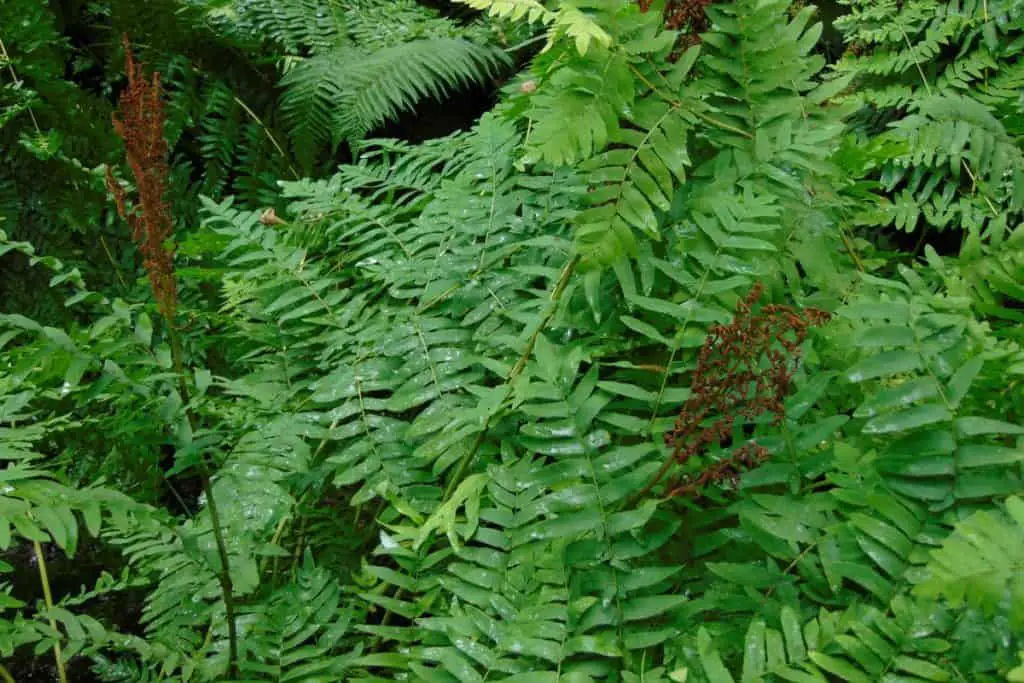
Indoors
The indoor environment is well suited to tropical varieties of ferns, because of the constant warm temperatures that most people prefer in their homes. In contrast to this benefit, a challenge is that many tropical ferns are adapted to high humidity, which is generally undesirable in the home.
There are several ways around this problem. First, ferns can be placed in naturally humid areas of the home, such as bathrooms, kitchens, laundry rooms or garden rooms. Second, ferns can be clustered close to other plants, to create a local “microclimate” where humidity is increased. Third, the ferns can be placed on a pebble tray or humidity mat, to increase moisture in the air immediately overhead through evaporation. Finally, and most drastically, a humidifier can be used to directly regulate the atmosphere around the ferns.
An alternative approach to these sorts of practical interventions is to select varieties of ferns that are less demanding, and more tolerant of drier conditions. Here are some of the best options.
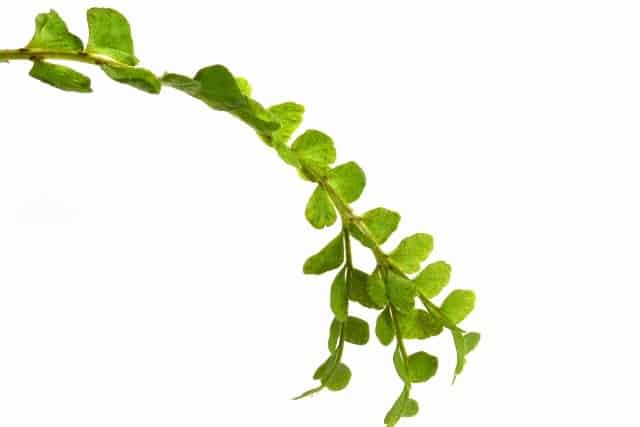
Lemon button fern
- Nephrolepis cordifolia (duffii)
- Evergreen
- Partial shade
- Height: up to 0.5 m
- Soil: acid or neutral. Moist, well-drained.
Lemon button ferns are renowned as excellent and robust houseplants. Their foliage is beautiful, with rounded pinnae on long elegant fronds. As the name suggests, the lemon button fern is scented, with the newly emerging fronds giving out a faint lemony scent (particularly when rubbed or bruised). These ferns like moist, but well-drained soil, and so do need to be watered regularly, but are tolerant of occasional neglect. Most people get great results with this all rounder.
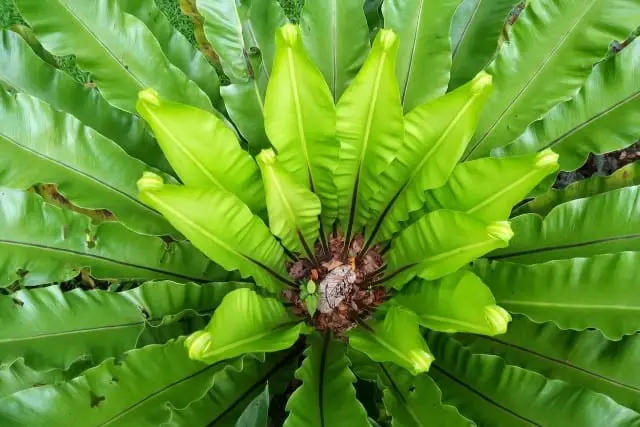
Bird’s nest fern
- Asplenium nidus
- Evergreen
- Partial or full shade
- Height: up to 1 m
- Soil: acid or neutral. Moist, well-drained.
Next up is the bird’s nest fern, with it’s wonderful crown of glossy, broad fronds. As with the lemon button fern, the Asplenium species ferns are not so dependent on humid conditions to thrive, but do prefer damp soil. There are several cultivars of Asplenium available, which can have strikingly different fronds, giving more options about the visual impact that can be made.
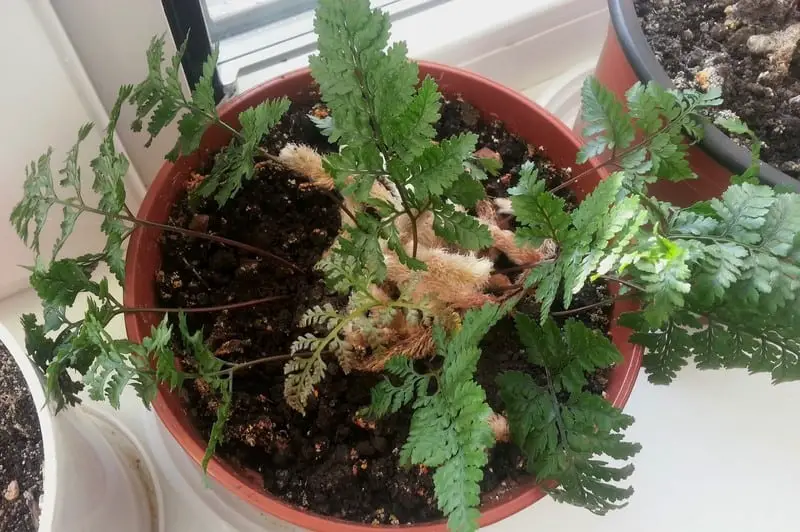
Rabbit’s foot fern
- Davallia solida (var. fejeensis)
- Evergreen
- Partial shade
- Height: up to 1 m
- Soil: acid or neutral. Moist, well-drained.
The Rabbit’s foot fern has delicate, finely divided fronds, overhanging the curious and characteristic furry rhizomes that give the plant its name. A robust but small fern, the Rabbit’s foot can reach up to one meter height under ideal conditions, but is usually much more compact when grown as a houseplant.

Kangaroo paw fern
- Microsorum diversifolium
- Evergreen
- Prefers partial shade
- Height: up to 0.5 m
- Soil: acid or neutral. Moist, well-drained.
In contrast, the Kangaroo paw fern can provide an overabundance of rich, green foliage. It grows well in hanging baskets, overflowing with broad, divided fronds that cascade over the sides. If you are looking for a fast and full growing indoor fern that is easy to maintain, the Kangaroo paw is an excellent choice.
Finally, one very popular fern that has a reputation for being difficult to manage is the Maidenhair fern.
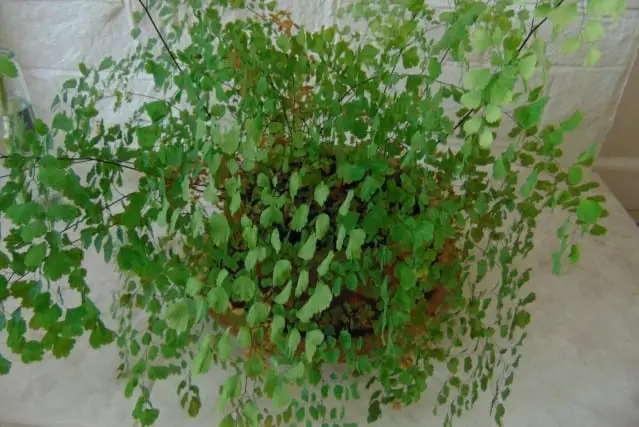
Maidenhair fern
- Adiantum raddianum
- Evergreen
- Partial shade
- Height: up to 0.5 m
- Soil: neutral or alkaline. Moist, well-drained.
You may be able to find the sweet spot needed for temperature and moisture, but if you are just starting out, a less sensitive alternative is a better bet than this famously fussy variety.
This small sample from the wide range of indoor ferns shows the diversity of styles that can be chosen from, even if you limit yourself to only the easiest of options. A full list of ferns is available that covers many more.
Outdoors
The best way to ensure success in growing ferns in the garden is to choose a variety that grows naturally in your region (or USDA zone). It’s always better to work with nature, and the local ferns will be perfectly adapted to your outdoor climate. The best way to find out which ferns are native to your state is to consult a local nursery or garden center. They will have the specific expertise and local wisdom needed to help you choose the best options.
That said, there are some noteworthy fern varieties that can thrive under almost any conditions, and are therefore worth considering as great “entry level” ferns.
First up is the Ostrich or Shuttlecock fern.
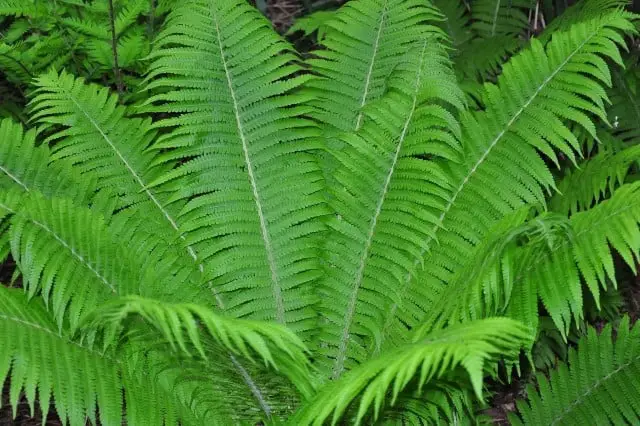
Ostrich fern
- Matteuccia struthiopteris
- Deciduous
- Full or partial shade
- Height: up to 1.5 m
- Soil: acid or neutral. Moist, well-drained.
This is a popular variety, and grows to form a striking and sculptural crown of large, feathery fronds. The Ostrich fern is robust, and will grow in most soil types, including wet soil around ponds and boggy ground. This variety does spread, forming new crowns from rhizomes that run under the soil. While this can be a problem if you want to restrict its range, it is usually easy to remove unwanted crowns, and they typically spread slowly, making maintenance straightforward.
Similar to the Ostrich fern, Male ferns will grow in a range of conditions, including both dry and wet soil.
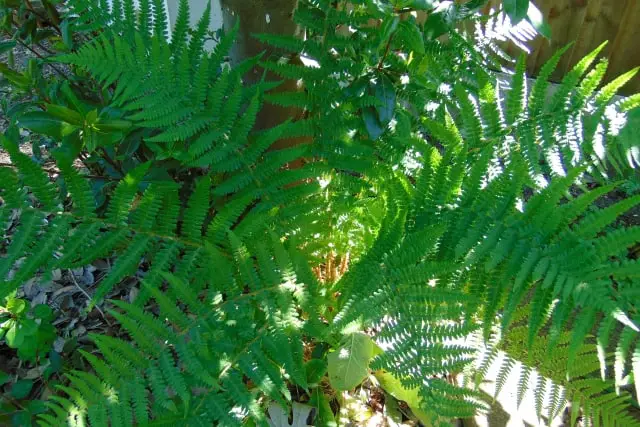
Male fern
- Dryopteris filix-mas
- Deciduous
- Prefers partial or full shade
- Height: up to 1.5 m
- Soil: acid, neutral or alkaline. Moist, poor drainage tolerated.
They prefer partial shade, but can cope with full sun. Male ferns are almost the archetypal fern – with a crown of green, segmented fronds with the classic fern pattern. They do not spread through the soil, but can spring up in odd corners around the garden due to scattered spores. This is testament to their resilience.
Another fern that can grow under a wide range of conditions is the Hart’s tongue fern.
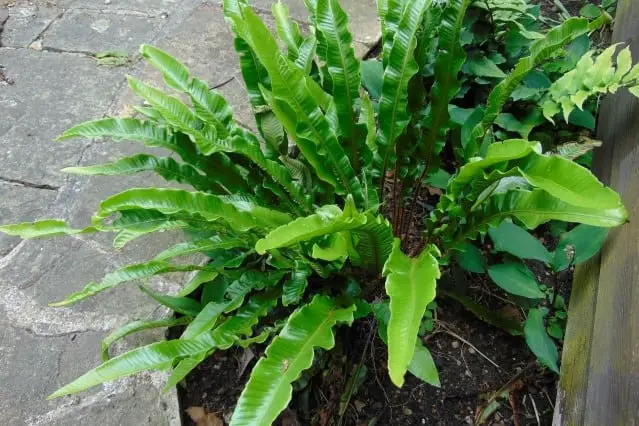
Hart’s tongue fern
- Asplenium scolopendrium
- Evergreen
- Prefers partial or full shade
- Height: up to 0.5 m
- Soil: alkaline or neutral. Moist, well drained.
With broad, glossy fronds similar in character to the Bird’s nest fern, Hart’s tongue fern are able to grow in almost any niche. As long as the spot is not in full sun, Hart’s tongue ferns can generally thrive. As with Male ferns, the Hart’s tongue can also spread by spores, finding purchase in the most unlikely of spots.
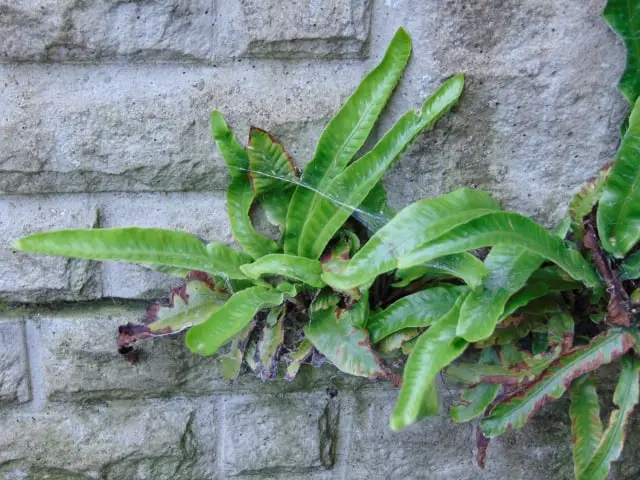
Ferns for dry and wet conditions
The general all-purpose ferns above will grow well in most gardens, but there are some special cases where a more specific variety is recommended if you want them to grow easily.
In sunny gardens, many ferns will suffer damage to their fronds, stunted growth, and may even die. That calls for a variety that is able to grow in full sun.
King fern is a great choice. It has the classic beauty of a Male fern, but with even more resilience to sunny and dry conditions. However, even King fern can suffer under very hot and dry conditions, and in that case, desert varieties like the lip ferns are called for.
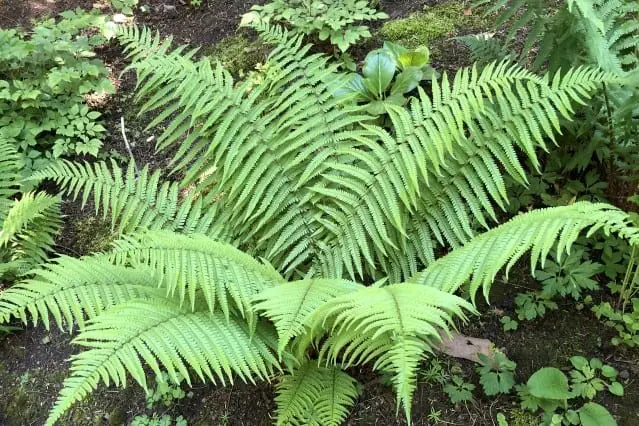
King fern
- Dryopteris affinis
- Semi-evergreen
- Shade, partial or full sun
- Height: up to 1.5 m
- Soil: acid, neutral or alkaline. Moist, well-drained.
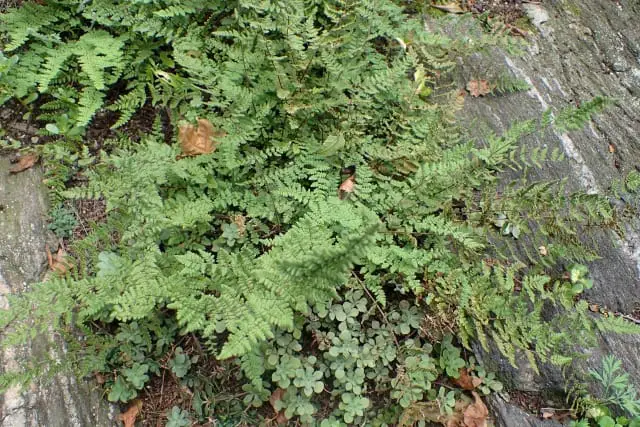
Hairy lip fern
- Cheilanthes lanosa
- Evergreen
- Full sun
- Height: up to 0.5 m
- Soil: acid, neutral or alkaline. Moist, well-drained.
Image credit: Krzysztof Ziarnek
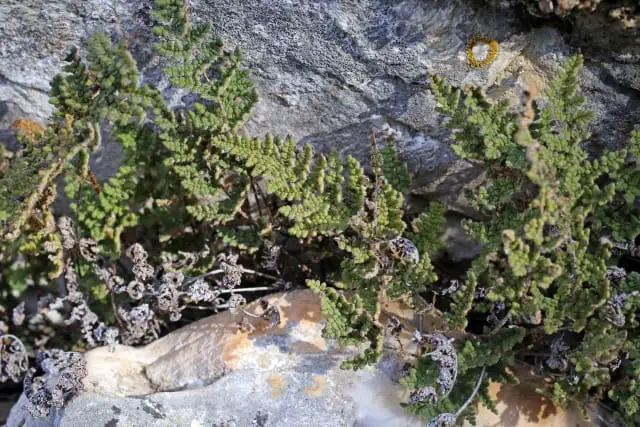
Woolly lip fern
- Cheilanthes tomentosa
- Evergreen
- Full sun
- Height: up to 0.5 m
- Soil: acid or neutral. Moist, well-drained.
At the opposite extreme, many ferns will struggle in very wet and waterlogged conditions. The Royal fern is a good option in that case, as it prefers very damp soil.
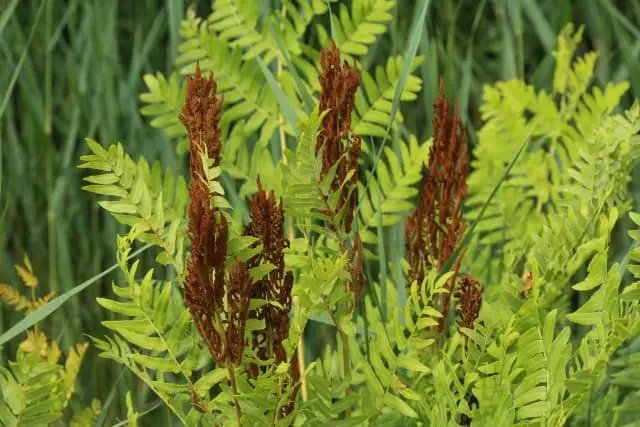
Royal fern
- Osmunda regalis
- Deciduous
- Full or partial shade, and full sun
- Height: up to 2.5 m
- Soil: acid, neutral or alkaline. Moist, poor drainage tolerated.
Be warned, though, that the Royal fern can grow to an epic size – spreading more than 2 meters high and wide from a single specimen when conditions are ideal.
Hard ferns are a more modest option for wet areas.
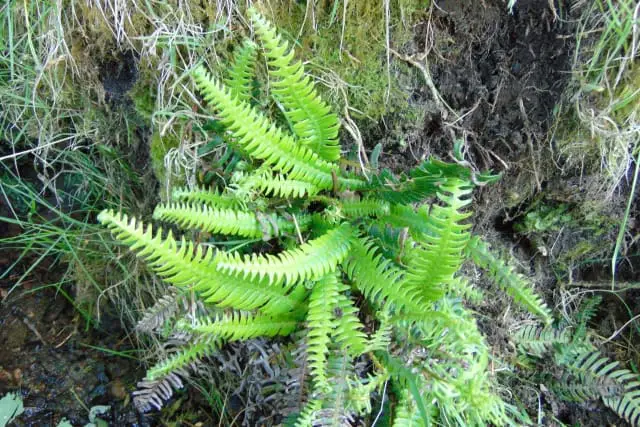
Hard fern
- Blechnum spicant
- Evergreen
- Prefers partial or full shade
- Height: up to 0.5 m
- Soil: acid or neutral. Moist, poor-drainage tolerated.
Often found on the side of streams or in boggy land, the Hard fern has long, serrated fronds that are striking and attractive. It also forms separate fertile fronds when mature that turn brown and form an interesting contrast to the sterile fronds beneath.
Ferns to avoid
Finally, it is worth noting a couple of ferns that are a little too easy to grow. Hay-scented ferns and bracken fern are very abundant in wild woodland, and spread invasively.

Hay-scented fern
- Dennstaedtia punctilobula
- Deciduous
- Full or partial shade
- Height: up to 1 m
- Soil: acid or neutral. Moist, well-drained, and tolerates dry soil.
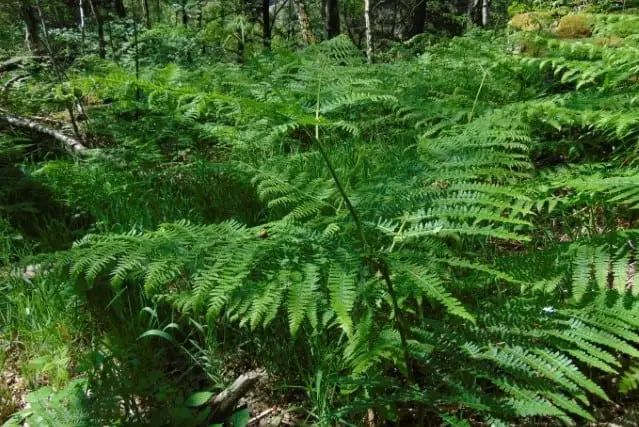
Common bracken
- Pteridium aquilinum
- Deciduous
- Prefers partial shade or full sun
- Height: up to 1 m
- Soil: acid, neutral or alkaline. Moist, well-drained.
If you have a large plot and want to discourage deer, then it can be worth considering introducing one of these species, with the understanding that you are likely to have to manage them to prevent uncontrolled spread. For most people, these varieties should be avoided. They will take over a small plot, and are difficult to control once established, due to spreading rhizomes that penetrate the soil in all directions.
It’s one thing to prefer a fern that is easy to grow, but there is a difference between “low-maintenance” and “aggressive weed”.
There are many varieties of ferns that are easy to grow. It’s all about matching the fern to the condition, but even that can be simplified by opting for good all-rounders that can thrive in almost any niche. Wherever you are, and whatever your needs, there is a fern out there that can meet them.
